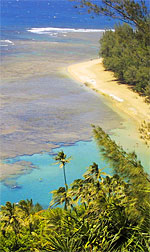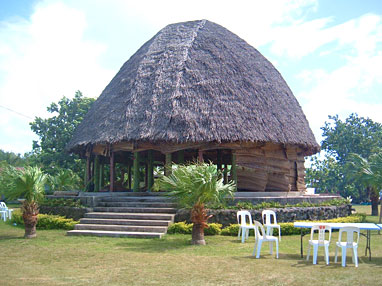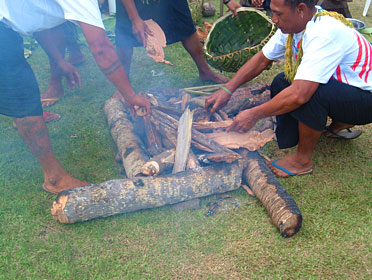PARBICA Conferences

PARBICA 14 REPORT
Apia, Samoa
August 22-27, 2011
The theme for the Pacific Regional Branch International Council on Archives (PARBICA) Fourteenth Biennial Conference was Evidence and Memory in the Digital Age. As technology becomes more robust in the South Pacific region, the Digital Age will provide new opportunities for archivists and records managers to make better connections with users and their collections. Additionally, digitization projects will preserve fragile records, as well as support the government's commitments to good governance. Over a hundred participants including archivists, records managers, librarians, ministry employees, and volunteers from around the Pacific attended the weeklong proceedings. The Prime Minister of Samoa, Honorable Tuilaepa Lupesoliai Sailele Malielegaoi, gave the opening address of the conference and stressed his support of the mission of PARBICA comparing archivists to oral history, "... archives teach us about people, expose truth, and create heroes and heroines." He was proud to announce that this year's meeting is the biggest PARBICA Conference in its thirty year history. Participants spent the next two days engaged in a couple of important workshops that are relevant to the Pacific Islands' record keepers.
Workshop #1
The first workshop focused on strategies to digital record keeping. The risks and benefits of a digitization project were considered, followed by a lengthy discussion on the myths that arise with digital recordkeeping. Some of these myths include:
- Everything on the computer is safe
- Digital storage is cheap
- Computers will create a paperless office
- Work on my computer is my own personal property
- Databases are a reliable form of evidence
- Outsourcing will solve all my problems
- I will be able to access all my records in 10 years
Another hot topic during this workshop dealt with the capture and management of e-mails. This is not easy to do. However, it was agreed among the participants that staff need rules about what to capture, who will capture, and where to capture e-mails for ongoing management.
After this, the participants heard about two successful digitization projects that took place in South Pacific organizations. The first project was conducted by the Archives of the Ministry of Education, Sports and Culture in Samoa to digitize the records of the German Administration of Samoa from 1900-1914. Their objective was to preserve the German records and to produce and deliver copies for the Federal Republic of Germany. The second project was the ongoing work performed by the Pacific Manuscript Bureau (PMB). Based at the Australian National University in Canberra, Australia, this organization is dedicated to the long-term preservation and accessibility of the documentary heritage of the Pacific Islands. PMB still uses microfilm, as they are unconvinced that digital records will last. Their archive is the most extensive collection of non-Government documentation on the Pacific Islands, and includes over 3,300 rolls of microfilm and related published indexes.
Workshop #2
The second workshop was about Disaster Preparedness and Response in the Pacific. PARBICA wants to create a Disaster Management Toolkit that Pacific Island archives can resort to during preparations and response to a disaster. This workshop turned out to be a hands-on experience, as participants became involved with brainstorming ideas relevant to the region that can be placed in the toolkit.

Cultural Tour
On Wednesday the entire PARBICA group went on a Samoan Cultural Tour to Amaile Village, Aleipata. The village is located at the eastern most point of Upolu Island and is the site for many Samoan legends. Amaile has approximately thirty households that treated the group with kindness and enthusiasm throughout the entire day. The morning started with a welcoming ava ceremony hosted by the village. Ava, like kava in Vanuatu, yaqona in Fiji, and 'awa in Hawaii, is made from the roots of the kava plant that is used to produce a drink with sedative and anesthetic properties. After this, the participants were treated to a traditional Samoan breakfast, as well as a plethora of village activities:
- Coconut tree climbing and picking
- Coconut husking, scraping and squeezing
- Visiting the Pool of the Young Man
- Preparing and making luau
- Baking food items in an umu

Perhaps, the highlight of the day, however, was the traditional dances and skits that the village members of all ages performed for the group. This worked up everyone's appetite, and after the show, all partook in a tasty lunch that included fish, octopus, taro, tafolo, and much, much more. It truly epitomized the South Pacific feast!
On our return back to Apia, we traveled through the area that was hit by a tsunami on September 29 2009 that was generated from a magnitude submarine earthquake 8.1. The wave destroyed approximately twenty villages along the south side of Upolu. The wall of water was massive, as the cliffs above the village of Lalomanu were scoured out to a height of 33-49 feet!
PARBICA Program
For the rest of the week the conference program changed from workshops to tackling issues regarding South Pacific archives and their collections. Keynote speaker, Mr. Tunumafono Apelu Afemata Aiavao, Samoan author, editor and chief, had the honor to kick-start this segment of the conference. Mr. Aiavao reminded the participants that archives means much more than just what is stored in a repository. He states, "…that archives today can be physical, verbal and virtual." Mr. Aiavao recommended that archivists make archives user friendly, but also stressed his concerns over how safe records are with modern technology.
After Mr. Aivao's talk, the group heard the latest developments and issues from PARBICA member's country, state and territory representatives. This also included major achievements and challenges since the last conference in 2009. Other informative presentations included lessons learned after implementing recordkeeping strategies, working with local communities, and educational opportunities in the Pacific. Finally, there a few representatives from Pacific archives gave brief reports on actions towards preparedness and response to disasters. These included:
- Cyclone Heta in Niue, 2004
- Earthquake and tsunami in Samoa, 2009
- Collapse of the Cologne Archives in Germany, 2009
- Christchurch Earthquake, 2011
These repots reminded everyone that Pacific archives are in a very volatile part of the world, and even being very prepared for a natural disaster can still leave you vulnerable. The recovery process still continues for each of these archives. Nevertheless, it was agreed by all those who suffered through these disasters that everyone is responsible to be prepared, making back-ups, and having staff and IT understand their role were critical lessons learned.
All in all, it was a very informative week. It was a terrific opportunity to connect with old colleagues and meet new ones. Tackling the issues pertaining to the South Pacific archives is not an easy task. However, by getting together every two years, members can highlight common issues and put forth recommendations and suggestions to combat these concerns.

Much appreciation is owed to the people of Samoa for hosting the weeklong event. Their wonderful, lighthearted hospitality and vivacity truly made this a very special conference that will be remembered for a long, long time.
